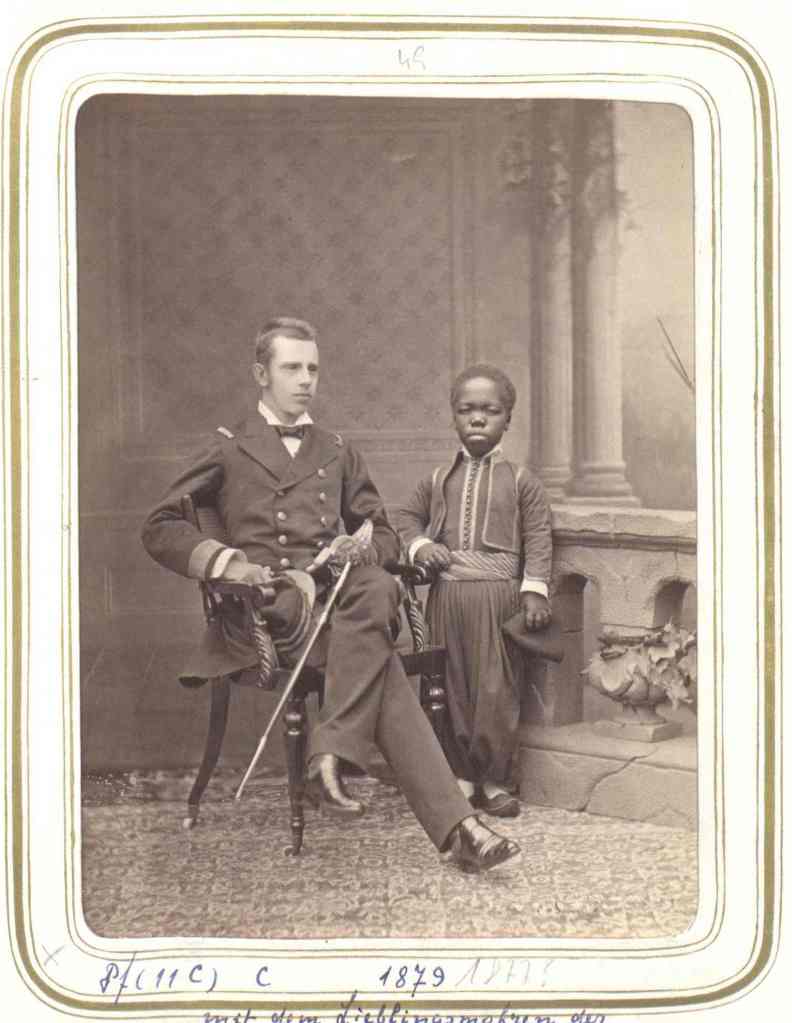Rudolph was born Mahmud Rustimo in Sudan in the early 1860s. We can only hypothesize about his early childhood experiences, but he was most likely taken into slavery and later was held under the guardianship of Ismail Pasha, the Khedive of Egypt and conqueror of Sudan at the time. Pasha presented Rustimo as an exchange gift to the Austrian Duchess Elisabeth Amalie Eugenie during an international exhibition in Vienna in 1873. Rustimo’s journey has parallels with the early experiences of Angelo Soliman (ca. 1721-1796) and especially with August Sabac el Cher (ca. 1836-1885), who was also a Sudanese boy sold into slavery in Egypt and gifted to a German noble family.
Prior to Rustimo’s arrival, Duchess Eugenie was in search of a playmate for her daughter Princess Marie Valerie, who had been given a macaque monkey to serve this purpose. The monkey frightened courtiers, became sick, and was eventually sent to Schönbrunn Zoo. The search for a replacement proved unsuccessful, but Princess Marie Valerie was soon to be given Rustimo as a new exotic playmate. Rustimo was disabled and dark-skinned and was also short of stature, which led to household tutors, masters, and ladies in waiting refusing to have anything to do with him. Despite this, Rustimo became, in the words of a 1932 press report, “one of the biggest sensations in Vienna for years” and was often seen in the entourage of the court, which reportedly gave rise to a multitude of gossip.
Rustimo was given a range of daily chores. He accompanied Marie on walks, performed servant duties, conducted administrative tasks, and later learned the bookbinding craft. Rustimo was baptized around 1878, when he received a new first name, “Rudolph,” after his godfather Crown Prince Rudolf.
The stately photograph of Rustimo was taken in 1877 with Crown Prince Rudolf in the uniform of a naval captain. It suggests a degree of acceptance for Rustimo, who appears formal and well dressed, playing the role of a servant and exotic showpiece. According to Christine Sulzbacher, Rustimo often“wore wide white harem pants with a wrapped belt that was pinned with a gold pin, a silk shirt with a light bandage, a blue jacket and a red, sloping fez with a long tassel on his head. In addition to the robe, he was often dressed in European clothes and wore high black leather boots.”
As Princess Marie grew older, her interest in Rustimo faded, and in February 1884 he was given a new role as a court announcer. Princess Marie attempted to secure Rustimo’s long-term position and gave him a yearly wage of 200 Gulden, which later increased to 600 Gulden paid out from the household’s private funds. However, by 1890 Rustimo’s physical and mental health began to deteriorate, and a year later he was in an unfit state to work. He was assessed by a household doctor, who diagnosed him with alcoholism and professed very little scope for recovery due to his poor cognition. Shortly afterwards, Rustimo was removed from the household court and sent to a care institution in the town of Ybbs by the Danube, where he stayed until his death on 27 July 1892.
Rustimo’s early experiences in Austria illustrate how a Black child at court could be dehumanized, perceived to have animal-like characteristics suitable for a princess’s pet playmate. Like other Black members of German courts, Rustimo could take advantage of the privileges available to him once baptized but this did not spare him from distress and suffering, ending his life in a care facility once his purpose was fulfilled.
Patrick Edore

Source: “Photograph of Crown Prince Rudolf and Rustimo (1877),” Österreichische Nationalbibliothek.
Rudolph Rustimo (ca. 1861-1892) by Patrick Edore is licensed under a Creative Commons Attribution-ShareAlike 4.0 International License. Permissions beyond the scope of this license may be available at https://blackcentraleurope.com/who-we-are/.
